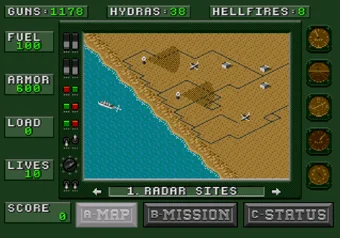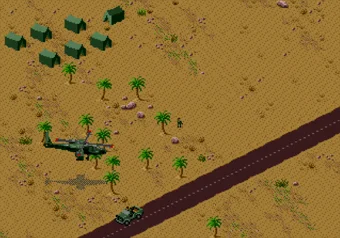🎯 Tips & Tricks for Desert Strike: Passwords, Extra Lives, and Hidden Secrets
Looking to get an edge in Desert Strike: Return to the Gulf? Whether you're stuck on a tough mission or just want to explore hidden features, these tips will help you get the most out of the game. From level passwords to secret cheats, here's what you need to know before takeoff.

Level passwords
To skip ahead to later missions, you can use level passwords. From the main menu, go to the campaign menu screen by pressing Space, then enter one of the following codes to jump straight into a specific campaign:
- Campaign 2 - Scud Buster: LQAHQRL
- Campaign 3 - Embassy City: ILLBWBY
- Campaign 4 - Nuclear Storm: BTOBKLW
These codes are especially useful if you want to explore later levels or replay specific missions without starting over.

Start with 10 lives
To begin the game with 10 lives, press Space on the main menu to access the campaign menu screen. Once you're there, enter the code:
BQQQAEZ
After activating the cheat, you'll start with 10 lives. You can then enter any level password to begin a specific mission - your extra lives will still apply.

Hidden Secrets and Fun Extras
- Secret Opening: At the title screen, press K to view a hidden opening sequence that's not shown during the normal intro.
- Unlimited Fuel: Fly over water - specifically the ocean - and your helicopter won't consume any fuel while you're above it. A useful trick for stretching your missions.
- Fire Missiles on the Title Screen: While on the title screen, wait until the helicopter is flying horizontally across the screen. Then press Space to make it fire missiles - just for fun!
🧠 Fun Facts About Desert Strike: Return to the Gulf
Desert Strike isn't just a classic SEGA Genesis/Mega Drive title - it's a game with a surprising amount of depth, historical influence, and unique design choices that made it stand out in the early '90s. Here are some fascinating facts that highlight why this game left such a strong impression on players and critics alike:
🎖 Inspired by Real-World Conflict
Released in 1992, Desert Strike drew direct inspiration from the Gulf War, which had concluded the year before. While the storyline is fictional, the themes of military intervention, Middle Eastern settings, and political tension clearly mirror real-world events. This gave the game a grounded, topical feel that was unusual for action titles of the time.
🚁 Originally a Sci-Fi Game
Early in development, Desert Strike wasn't supposed to be a modern military game at all. The concept started as a futuristic sci-fi shooter featuring robots and aliens. However, the idea was eventually reworked to reflect real-world military hardware and conflicts, which helped give the final game its unique tone and style.
🔇 No Music During Missions
One of the most notable design choices in Desert Strike is the absence of background music during gameplay. Instead, you hear only the sounds of rotor blades, gunfire, explosions, and radio chatter. This minimalist soundscape was a deliberate decision to make the missions feel more tense and realistic.
📺 Military Footage as Reference
To get the look and feel of modern warfare right, the developers reportedly studied hours of real military footage, including helicopter gunship operations. This attention to detail helped shape the isometric perspective, weapon systems, and overall atmosphere of the game.
🕹 Strategic, Not Just Arcade
Unlike many shooters of its time, Desert Strike requires more than fast reflexes. Resource management - fuel, ammo, and armor - is key to survival. Players also need to plan their routes and mission order carefully, adding a layer of tactical gameplay rarely seen in other Genesis/Mega Drive-era shooters.
📦 Environmental Hazards and Realistic Damage
The game features not just enemy threats but also environmental dangers like land mines, anti-aircraft turrets, and fuel shortages. Taking damage doesn't just cost you a life - it can impair your helicopter's ability to fly, making it harder to maneuver or attack.
🎮 A Trilogy in the Making
Desert Strike was the first in what would become a trilogy. It was followed by Jungle Strike and Urban Strike, each expanding on the formula with new vehicles, missions, and storylines. All three games share a similar core mechanic and visual style, making them one of the most consistent action series of the 16-bit era.
📈 Huge Commercial Success
Despite its serious tone and unconventional gameplay, Desert Strike became one of the best-selling SEGA Genesis/Mega Drive games of its time. Its success helped solidify Electronic Arts as a major publisher on consoles - not just PCs.
🎯 Used in a Real-Life Controversy
Due to its political themes and timing, Desert Strike wasn't free of criticism. Some players and reviewers found its use of real-world conflict as a backdrop controversial, while others praised it for taking a more serious approach to storytelling in games.
✈️ Final Thoughts
Desert Strike: Return to the Gulf is more than just a military shooter - it's a game that successfully blended arcade action with tactical depth at a time when most titles stuck to one formula. Its isometric perspective, grounded story, and challenging mission structure gave players a completely different kind of experience on the SEGA Genesis/Mega Drive.
What really sets Desert Strike apart is its pacing and atmosphere. With no background music during missions and a focus on managing resources like fuel and ammo, the game creates real tension. Every decision - whether to press forward, retreat, or search for supplies - matters. It rewards careful planning just as much as quick reflexes.
Even today, it's easy to see why this game stood out. It was bold, it felt real, and it offered a type of gameplay that still feels unique decades later. Whether you're returning to it after many years or trying it for the first time, Desert Strike remains a powerful example of how strategy and action can work hand in hand.
Ready to get back in the cockpit? You can play Desert Strike: Return to the Gulf online right here and experience one of the most iconic tactical shooters on the SEGA Genesis and Mega Drive - no downloads, just pure 16-bit action in your browser.
